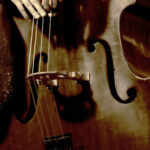A lot of people who haven’t studied music get annoyed with certain vocal trends in music (and used on “American Idol”)–yet can’t really describe what the term is when they want to elucidate what they’re opinions are in an open forum. The word that’s most likely the one they’re thinking of is “melisma”, which probably gets described in a more apropos light of “histrionic singing (or rapid-fire pitch changes) on one note.” And, yes, that’s a more crass way to define what a melisma is–both in a classical sense and a pop music sense. What’s amazing here, though, is the evolution the melisma took in the history of music theory. What’s truly annoying is the abuse of it in the music world and how it’s become as ubiquitous as…well, talking too much.
You probably wouldn’t be all that much surprised to learn that the melisma was used for hypnotic purposes in ancient cultures and in chants for certain mysterious rituals. That process is probably still being implemented to some eerie degree in the mainstream music industry today. But while it was used in mystical realms early by the Greeks to please their gods–later Christians (especially the Catholics) took the melisma and applied it to Gregorian chants as a decorative way to make musical scales not so dreary and boring. Well, it was quite ubiquitous in its spiritual quality–considering all cultures around the world started taking the melisma to the extreme. All of the major faiths in the Middle East took it on and used it very histrionically before the Catholic Church grabbed it–and, of course, you can still hear it used in all the religious music of each. Much of it, though, is still done in taste and not too excessively.
Just what made the melisma so attractive to all the different religions that couldn’t be more different? It obviously created some kind of high that likely gave the feeling that they were praising God in the fullest way they knew how. Call it what you want (or even contrived), but some today might call it the arguably Ray Charles-invented “Soul”–or how the euphoria you get when you allow yourself to take your voice into amazing histrionic territory that can rouse passions. It’s no wonder the melisma was adopted into R&B; music and especially gospel during the 20th century.
Yes, people tend to forget just how a musical device can tie every religion of the world together.
It’s quite interesting then that the melisma still managed to stay within a religious context–even when gospel music from African-Americans starting in the 19th century eventually coalesced with the mainstream music charts…
African-Americans take the melisma to amazing places…
When you hear the music from Africa–you don’t really hear a lot of melismas used, for whatever mysterious reasons. They were more about centering in on rhythm. The African-American culture didn’t start using the melisma until gospel churches sprung up in the south during the late 19th century. By the 20th century–America generally heard the melisma only in the black churches where a lot of spiritual songs used melismatic touches to create enough passions to bring the house down. Who exactly started placing melismas in the African-American spiritual is sort of a musical history mystery. It obviously was more than one person or preacher, but it shows how much the black community brought to America in the way of music and bringing a new way to express ourselves based on ancient traditions.
Whether you agree that Ray Charles invented Soul Music or not–it seemed to be the more or less consolidation that church music and pop music finally received when he started doing his first recordings in the early 1950’s. As Rock n’Roll stayed away from using too much melisma in the beginning–the African-American music market of Rhythm & Blues plus Soul took the melisma onto the little turntables of kids all over the world who probably had never heard a melisma in a religious sense nor in a gospel church.
Finally, Motown took it to the level that started a landslide–however you want to look at it. That’s when a little girl named Whitney Houston listening to people like Marvin Gaye and Diana Ross & The Supremes (spiritually?) was tapped to be the future of how we’d end up viewing the melisma…both negatively and positively.
The torch-pass from Whitney to Mariah…to every singer on “American Idol”…to those who sing the National Anthem…
Whenever you come across the rare analysis of the melisma on the net (and this one is only one of about less than ten)–you’ll always see a mention of Whitney Houston as being the singular artist who took the melisma to a new high in the Top 40. By this time, people might have been calling them “vocal runs” as a way to describe how Whitney would take one note and create a long vocal flourish for several seconds. This was obviously effective in her soaring ballads that already had touches of something you’d hear in a gospel choir. There isn’t any doubt that Whitney brought elements of that to her singing based on her personal passion for the church in those days. During her TV debut days–it wouldn’t be out of the question to see her singing at least one black spiritual song and displaying her artful use of the melisma.
Well, Whitney seems conservative in melismatic quality today compared to her logical successor: Mariah Carey. When Mariah arrived on the scene, she decided to make the melisma more pronounced or just downright extended. It was the first time we heard a pop hit where one syllable was stretched out for over ten seconds. This, of course, was a profound musical move that probably slipped under musical analysis radar in the beginning.
What wasn’t noticed was this was the time when future “American Idol” contestants were assimilating everything on the radio. Hearing Mariah’s harder melismas was just too powerful to not absorb and imitate when you’re a little kid with aspirations to be a pop star someday. Yes, even guys worked on all those Mariah-influenced melismas. (For the record, I didn’t.)
Once the “American Idol” era hit–you had a whole series of Mariah-influenced singers who think that the more melisma used…the better. Now when you watch “AI”, you can’t see any audition horrible to quite good without hearing someone take one word in a song and make it last for an exaggerated five minutes.
Of course, what would our National Anthem be without hearing most Mariah-influenced singers taking “O say can you see” and turning it into a melismatic frenzy?
Fortunately, more people in America are into minimalism lately–and those who take the melisma to annoyingly dizzying heights are just looked at as being our magic word from the beginning: histrionic…





